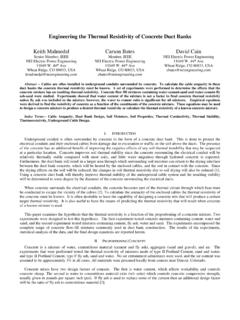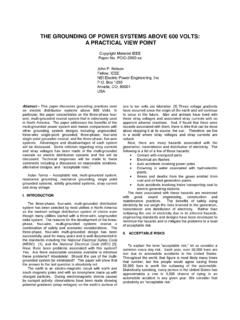Transcription of DC-Arc Models and Incident-Energy Calculations
1 1810 IEEE TRANSACTIONS ON INDUSTRY APPLICATIONS, VOL. 46, NO. 5, SEPTEMBER/OCTOBER2010DC-Arc Models and Incident-Energy CalculationsRavel F. Ammerman,Senior Member, IEEE, Tammy Gammon,Senior Member, IEEE,Pankaj K. Sen,Senior Member, IEEE, and John P. Nelson,Fellow, IEEEA bstract There are many industrial applications of large-scaledc power systems, but only a limited amount of scientific literatureaddresses the modeling of dc arcs. Since the early DC-Arc researchfocused on the arc as an illuminant, most of the early data wasobtained from low-current dc systems. More recent publicationsprovide a better understanding of the high-current dc arc.
2 Thedc-arc Models reviewed in this paper cover a wide range of arcingsituations and test conditions. Even with the test variations, acomparison of DC-Arc resistance equations shows a fair degree ofconsistency in the formulations. A method for estimating incidentenergy for a dc arcing fault is developed based on a nonlineararc resistance. Additional DC-Arc testing is needed so that moreaccurate Incident-Energy Models can be developed for dc Terms DC-Arc modeling, DC-Arc resistance, dc Incident-Energy Calculations , dc-system hazard risk category evaluation,free-burning arcs in open air, volt ampere (V I) INTRODUCTIONARC physics is complex, and the physical constants areparticularly hard to clearly define for real-world arcingfaults in power systems.
3 Therefore, the present knowledge hasbeen largely developed based on the observation and analysis ofelectrical measurements. The volt ampere (V I) characteris-tics of electric arcs, which are dependent on test parameters, areessential to defining the complex arc phenomenon in power sys-tems. Early researchers often failed to specify test conditions,the configuration type, and if ac or dc arcs had been theV Icharacteristic is dependent on test conditions,including gap width and relative current magnitude, it can bedifficult to assess the early published work for accuracy current magnitudes (on the order of kiloamperes),typical of arcing faults in power systems, are commonly viewedas being quasi-stationary because the large thermal inertia inthe arc discourages changes in arc temperature and conduc-tance.
4 Even though the dynamic nature of the arc generatesa time-varying arc length, arc voltage equations have beenManuscript received June 22, 2009; accepted January 24, 2010. Date ofpublication July 12, 2010; date of current version September 17, 2010. Paper2009-PCIC-185, presented at the 2009 IEEE Petroleum and Chemical IndustryTechnical Conference, Anaheim, CA, September 14 16, and approved forpublication in the IEEE TRANSACTIONS ONINDUSTRYAPPLICATIONS bythe Petroleum and Chemical Industry Committee of the IEEE Industry Appli-cations F. Ammerman and P. K. Sen are with Colorado School of Mines, Golden,CO 80401 USA (e-mail: Gammon is with John Matthews & Associates, Cookeville, TN 38502 USA (e-mail: P.))
5 Nelson is with NEI Electric Power Engineering, Arvada, CO 80001 USA(e-mail: versions of one or more of the figures in this paper are available onlineat Object Identifier 1. Series-electrode arc classification [2].developed from the quasi-stationaryV Icharacteristics. Thispaper provides an overview of the most commonly used andpublished arc equations and develops DC-Arc -resistance simulation study is performed to compare the formulas whichare relevant with present DC-Arc research. Additionally, basedon these Models , dc arcing-fault Incident-Energy calculationsare presented to assess the level of risk involved when workingaround high-current dc apparatus.)
6 The discussion begins with abrief summary of free-burning arcs in open FREE-BURNINGARCS INOPENAIRAs Sweeting and Stokes observed, The vast majority ofthe literature deals with arcs that have been constrained orstabilized. They also noted that The bulk of the arc literatureis based on single-phase opposing electrodes, where the currentcomes from one side and flows across to the other side [1].Series electrodes have historically received the majority ofattention because this is the configuration utilized to designpower-system protective devices like circuit breakers and this context, arcs are often divided into two main cate-gories: axisymmetric and nonaxisymmetric.
7 An axisymmetricarc burns uniformly, while nonaxisymmetric arcs are either in a state of dynamic equilibrium or continuous motion [2]. Fig. 1shows some of the commonly used arc wall-stabilized arc is constrained to a cylindricalshape. At low currents (below 10 A), the geometry of a free-burning arc would look similar to the diagram on the right sideof the figure. As shown, the actual arc length is longer thanthe electrode gap. Convective forces cause the arc plasma tobow upward; the resulting shape helps to explain the originof the term arc used to describe this complex $ 2010 IEEEAMMERMANet al.: DC-Arc Models AND Incident-Energy CALCULATIONS1811 Fig.
8 2. Electric-arc characterization [3], [4].Free-burning arcs in open air are the exclusive focus ofthis paper. In industrial applications, high-current free-burningarcing faults are extremely chaotic in nature. The arc movesrapidly so that its length and geometry are constantly contributing factors to the dynamic nature of high-currentfree-burning arcs are the following:1) thermal convection;2) electromagnetic forces;3) burn back of electrode material;4) arc extinction and restriking;5) plasma CHARACTERISTICS OF ANARCAs shown in Fig. 2, an arc consists ofthreeregions: theanoderegion, theplasma column, and thecathoderegion.
9 The elec-trode regions (anode and cathode) form the transition regionsbetween the gaseous plasma cloud and the solid shown in Fig. 2, an arc is also commonly associatedwith a voltage profile. The voltage gradient across the arcplasma depends on the actual arc length; the arc may deviatefrom the gap width between the electrodes. Less deviationis expected for short gap widths, series electrodes, and lessturbulent number of researchers have postulated that the voltagegradient in the plasma column of an arc is nearly independentof the arcing current. For example, Browne found that thevoltage gradient in the arc column is nearly independent of thearc current for magnitudes above 50 A and is approximately12 V/cm ( V/in) for arcs in open air [5].
10 Browne s researchinvestigated arc behavior in both dc and ac circuits. In 1946,Strom published that the voltage gradient in the arc is affectedvery little by current magnitude [6]. Strom found that, forarc gap widths from to 48 in ( to 122 cm), the arcvoltages averaged 34 V/in ( V/cm) during arc tests, whichproduced peak ac currents ranging from 68 to 21 750 A. Table Isummarizes the results of Strom s findings. These numbers arecomparable to Browne s ISTROM SAVERAGEVOLTAGEGRADIENT[6]Fig. 3. Arcing voltage and current characteristic [5], [7].Fig. 4. DC-Arc test circuit configuration [8].A. ArcV ICharacteristicsFig.







